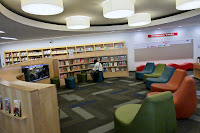Thursday, November 7, 2019
Andrew Carnegie Day (8/11/19) - Columbus Main Library
I'm not able to visit a new library this week because I’m staying home all week while workmen sand, prime, and paint our 45 year old kitchen cabinets. So I thought I’d report on a return visit to the Columbus Main Library for their Andrew Carnegie Day tour on August 11 this past summer commemorating the 100th anniversary of Carnegie’s death. The photo above shows me standing beside a cutout of Andrew Carnegie. Behind “us” is the face of the back wall of the original Carnegie library building. I was surprised to learn that Carnegie was just 4’ 10” tall, so I’m taller even when his top hat is included.
Andrew Carnegie donated $200,000 in 1907 to build the original main library. The building was expanded in 1991 and extensively remodeled in 2016. From 1883 until his death in 1919, Carnegie funded some 3000 libraries around the world, including 1700 in the U.S. of which 105 were in Ohio. The Carnegie Day walking tour focused on the interior and exterior architecture of the original building and an exhibit in one of the library’s galleries commemorating the life and times of Andrew Carnegie.
I must admit that I got so interested in the tour guides’ descriptions of the original building that I ended up not taking all that many pictures. I was fascinated by the detail work in the arches and skylights in the original book stacks of the library. I tried to imagine what it would have been like to browse in those stacks, although that would not have been possible. At that time, library patrons would request books, and the librarians would go into the stacks to get them.
The first photo of the exterior below is from the blog post for my previous visit on 12/11/18. The other two photos show some of the details of the building’s marble facade. That inscription in big, bold letters over the front entry, “OPEN TO ALL,” is so very important and never more so than in our diverse and divided world.
The hanging Vanitas sculpture by Todd Slaughter is a permanent installation in the lobby portion of the original Carnegie building. The small windows look out into the Grand Atrium. The artist describes his work as based on an “interpretation of ‘vanitas,’ a term referring especially to 17th century Dutch-Flemish still-life paintings in which bounty is symbolic of accumulated wealth and productivity, while also suggesting human vulnerability. The work includes symbols of written, spoken, and gestured language.”
At the close of the tour, we moved from the Carnegie building into the 3-story Grand Atrium that is part the 1991 addition. I’ve included a photo on the right from my previous visit looking from the third floor toward the original back wall of the Carnegie library.
Since it was a relatively quiet Sunday afternoon, I took the opportunity before the tour to photograph some parts of the library that I did not include in my previous blog post. For instance, the Children’s Area was so busy on that day that I gave up trying to get pictures that would not include identifiable children. The Children’s Area has both adult- and child-sized entrances off the Grand Atrium.
There is a large area devoted to Kindergarten Readiness. This program is not just in the library but involves library staff going into the neediest neighborhoods seeking out families with young children and even making home visits with board books, literacy kits, and invitations to the library and story hours.
There are a couple of large carpeted areas with comfortable seating and curved walls for storytelling or other programs. One of these includes a fish tank.
Also on on this side of the glass wall between the atrium and the children’s area there is a large teen area with a 2-story wall of windows as well as a dedicated Homework Help room (with college banners) and a classroom.
Before leaving the library, I wanted to take a look at the large reading room on the second floor. This area is used for author lectures as well as various service programs you might not expect in a library—such as the Job Boot Camp that was held last month (pictured on the right below) sponsored by a local television station to help job seekers learn how to find the right job and to meet with potential employers.
And one last closer look at parts of Aminah Robinson’s “Life in Sellsville 1871-1900” and “Life in the Blackberry Patch” murals on the Grand Atrium staircase. Robinson sought to celebrate these two important Columbus communities that no longer exist.
Subscribe to:
Post Comments (Atom)
























No comments:
Post a Comment